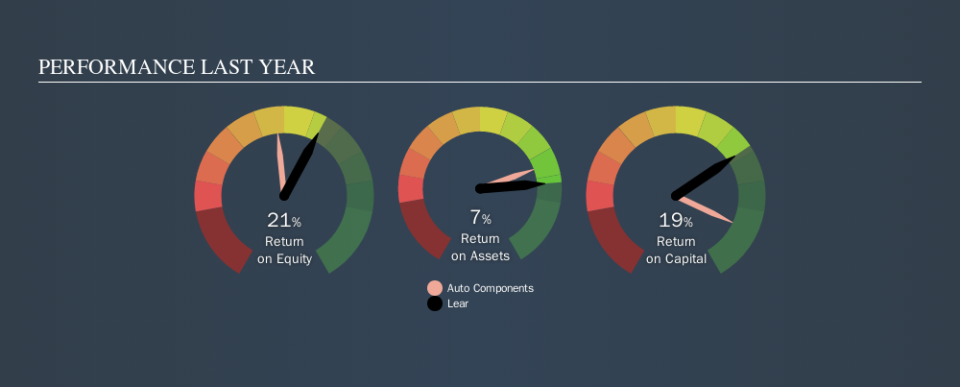A Close Look At Lear Corporation’s (NYSE:LEA) 19% ROCE

Today we'll evaluate Lear Corporation (NYSE:LEA) to determine whether it could have potential as an investment idea. Specifically, we're going to calculate its Return On Capital Employed (ROCE), in the hopes of getting some insight into the business.
First up, we'll look at what ROCE is and how we calculate it. Then we'll compare its ROCE to similar companies. Then we'll determine how its current liabilities are affecting its ROCE.
Return On Capital Employed (ROCE): What is it?
ROCE is a measure of a company's yearly pre-tax profit (its return), relative to the capital employed in the business. Generally speaking a higher ROCE is better. In brief, it is a useful tool, but it is not without drawbacks. Author Edwin Whiting says to be careful when comparing the ROCE of different businesses, since 'No two businesses are exactly alike.
So, How Do We Calculate ROCE?
The formula for calculating the return on capital employed is:
Return on Capital Employed = Earnings Before Interest and Tax (EBIT) ÷ (Total Assets - Current Liabilities)
Or for Lear:
0.19 = US$1.5b ÷ (US$13b - US$4.9b) (Based on the trailing twelve months to September 2019.)
So, Lear has an ROCE of 19%.
Check out our latest analysis for Lear
Does Lear Have A Good ROCE?
When making comparisons between similar businesses, investors may find ROCE useful. Using our data, we find that Lear's ROCE is meaningfully better than the 15% average in the Auto Components industry. We would consider this a positive, as it suggests it is using capital more effectively than other similar companies. Regardless of where Lear sits next to its industry, its ROCE in absolute terms appears satisfactory, and this company could be worth a closer look.
We can see that, Lear currently has an ROCE of 19%, less than the 26% it reported 3 years ago. So investors might consider if it has had issues recently. You can see in the image below how Lear's ROCE compares to its industry. Click to see more on past growth.
Remember that this metric is backwards looking - it shows what has happened in the past, and does not accurately predict the future. ROCE can be misleading for companies in cyclical industries, with returns looking impressive during the boom times, but very weak during the busts. ROCE is only a point-in-time measure. Future performance is what matters, and you can see analyst predictions in our free report on analyst forecasts for the company.
Do Lear's Current Liabilities Skew Its ROCE?
Short term (or current) liabilities, are things like supplier invoices, overdrafts, or tax bills that need to be paid within 12 months. The ROCE equation subtracts current liabilities from capital employed, so a company with a lot of current liabilities appears to have less capital employed, and a higher ROCE than otherwise. To check the impact of this, we calculate if a company has high current liabilities relative to its total assets.
Lear has total assets of US$13b and current liabilities of US$4.9b. As a result, its current liabilities are equal to approximately 38% of its total assets. Lear has a medium level of current liabilities, which would boost the ROCE.
The Bottom Line On Lear's ROCE
Lear's ROCE does look good, but the level of current liabilities also contribute to that. Lear shapes up well under this analysis, but it is far from the only business delivering excellent numbers . You might also want to check this free collection of companies delivering excellent earnings growth.
If you like to buy stocks alongside management, then you might just love this free list of companies. (Hint: insiders have been buying them).
We aim to bring you long-term focused research analysis driven by fundamental data. Note that our analysis may not factor in the latest price-sensitive company announcements or qualitative material.
If you spot an error that warrants correction, please contact the editor at editorial-team@simplywallst.com. This article by Simply Wall St is general in nature. It does not constitute a recommendation to buy or sell any stock, and does not take account of your objectives, or your financial situation. Simply Wall St has no position in the stocks mentioned. Thank you for reading.

 Yahoo Finance
Yahoo Finance 
